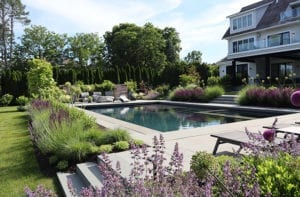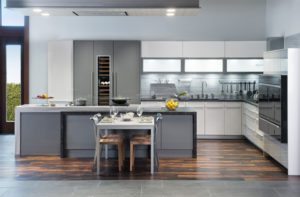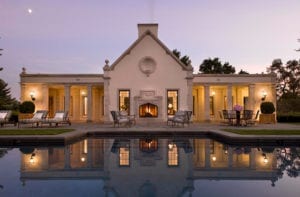A Designer’s Guide to War and Peace
June 29, 2011
Text by Louis Postel Photography by Michael Fein
When New Hampshire designer Treena Crochet told us she was in the green zone, she wasn’t talking about a fancy spa sporting reclaimed timbers and an infinity pool of reconstituted bottle caps. Crochet meant the military kind of green zone. Luckily, the protests and shooting didn’t get under way until after dark, giving her time to speed back from the University of Bahrain campus to the safety of her home in the zone. Crochet has been in Bahrain to launch a groundbreaking interior design program, which drew a large number of Saudi students across the King Fahd Causeway, at least until the route was blocked by tanks. Meanwhile, back in the U.S., Crochet’s latest book, A Designer’s Guide to Building Construction and Systems, recently made its debut.
Does violence advance design creativity and innovation? Or does it stand in its way?
Many great periods of creativity were eras of equally bloody carnage. Just consider the Italian Renaissance. Mercenaries in fourteenth- and fifteenth-century Italy terrorized the countryside from Siena to Naples, chasing lucrative contracts to vanquish this or that citizen or city-state. Green zones were pretty scarce, and yet when was there a period of greater creativity, more influential design and architecture? Design historians may have some useful insights into our confusing era five hundred years from now. The challenge for designers, architects, artists and others in the creative class will be to tease out some kind of meaning on a daily basis—whether in war or peace.
A step outside this publication’s offices in Boston’s SOWA district (south of Washington Street), signs of a full-blown design renaissance appear in storefront windows set in long blocks of old brick warehouses. Architect Russ Gerard of Gurari Collections calls his SOWA gallery and showroom his “chamber of curiosities.” There, a 1930s mirror tilted horizontally becomes a presentation stand; a collapsible wire laundry basket becomes a magazine holder. “I’m for objects and materials that tell a story,” Gerard says. “Recycled, repurposed or otherwise transformed, they continue to resonate with us. Take this 1739 map of Paris, nine feet high by eleven wide. It’s now an icebreaker. When guests arrive they recognize a street where they once had a café or meal . . . The map now has a new purpose.”
At Dennis Duffy’s D SCALE showroom on the same block, manager Rosie Cipriani is bringing in a line of architectural lighting by East Coast Modern. Based in Newburyport, Massachusetts, the firm produces finely turned and finished lamp bases that will feel right at home with the shop’s sophisticated offerings from design capitals around the world. For example, there’s a dining room table from Barcelona’s Alternative brand that Duffy found last year at Maison et Objet in Paris. How can a slab with four legs evoke such powerful emotions? Veneered in open-grain oak, it’s a wonderful piece that celebrates the pleasures of touch. “And look,” says Cipriani, “there are no leaves to wrestle with. The ends simply slide in and out.”
Further down Harrison Street, Kevin McPherson of Mohr & McPherson imports Asian furniture and architectural elements. Touching a Rajasthani doorframe that leans against one wall is like touching time itself. McPherson will soon leave for a months-long buying trip to India, Chiang Mai and Vietnam. “The good thing about the third world is that they throw nothing out,” says McPherson. “They keep everything. We may be like that someday in this country.”
Leaving SOWA for Boston’s Design District, we found Karen Clarke, co-director of the interior design program at the New England School of Art & Design at Suffolk University, reviewing a sustainability study by three teams of graduate students. Professors Sean Solley (architecture) and Greta Meszoely (economics, water resource management) joined her in the conference room as each of the teams presented far-reaching proposals to replace Suffolk’s R.S Friedman Field Station in Cobscook Bay, Maine, which was destroyed by mold. New England Home underwrote the study.
Education is an ongoing process, especially in a time of great change. That’s where architect Brenda Stanfield comes in. The founder and owner of Building and Design Resources in Cambridge, Massachusetts, Stanfield serves as a materials librarian and teacher for design firms throughout New England. “Sustainability is a thread that weaves itself through the selection of materials for higher-end residential construction, both single-family and multi-family, and traditional to modern,” Stanfield says. “Designing sustainably . . . is slowly becoming standard practice.” At Build Boston’s Innovation Pavilion in November, she will feature a host of the newest technologies for windows and floors, including fiberglass–framed windows to reduce thermal transmission and windows framed in Forest Stewardship Council–certified wood, all with low-E glazing; phase-change drywall sheathing to store or release heat; water-based, low- or no-VOC sealants and glazing compounds to prevent air, vapor and moisture penetration; and new under-floor heating options by Uponor and Nuheat that not only save heating fuel but work really well under the array of exquisite porcelain tiles available today. It’s thrilling to imagine the creative possibilities these materials may open for designers, architects and homeowners. Indeed, they portend a green zone within which we’d all love to live.
Share
![NEH-Logo_Black[1] NEH-Logo_Black[1]](https://www.nehomemag.com/wp-content/uploads/2022/08/NEH-Logo_Black1-300x162.jpg)







